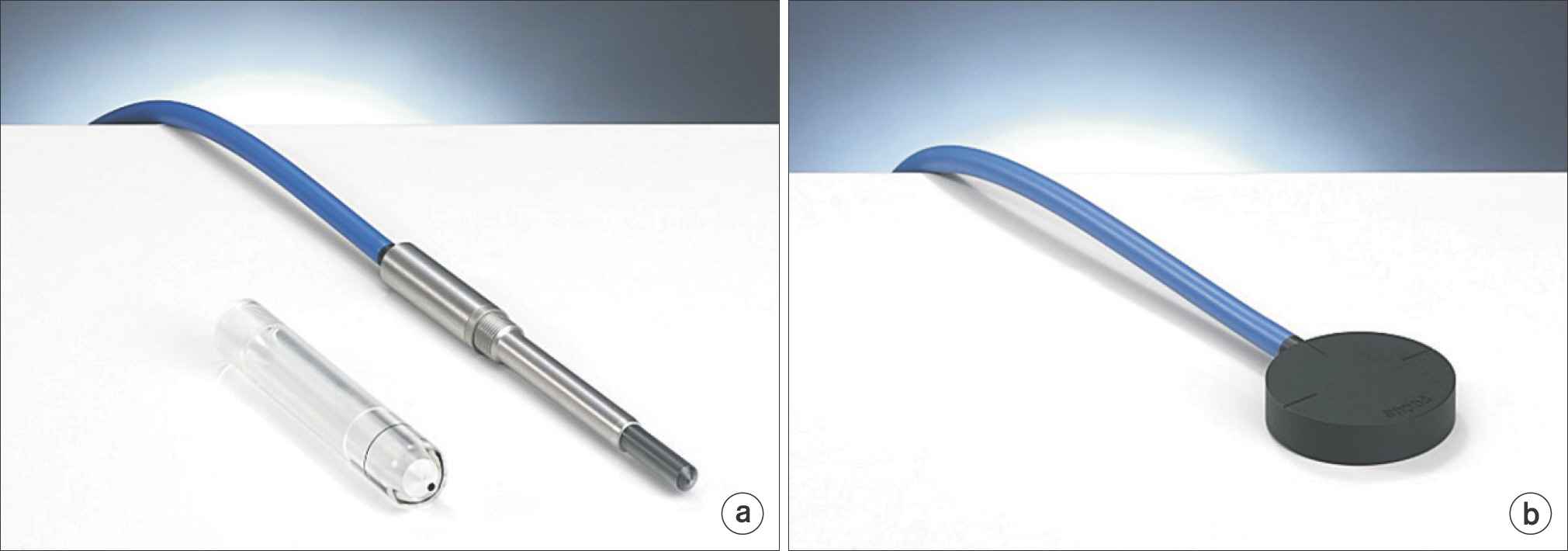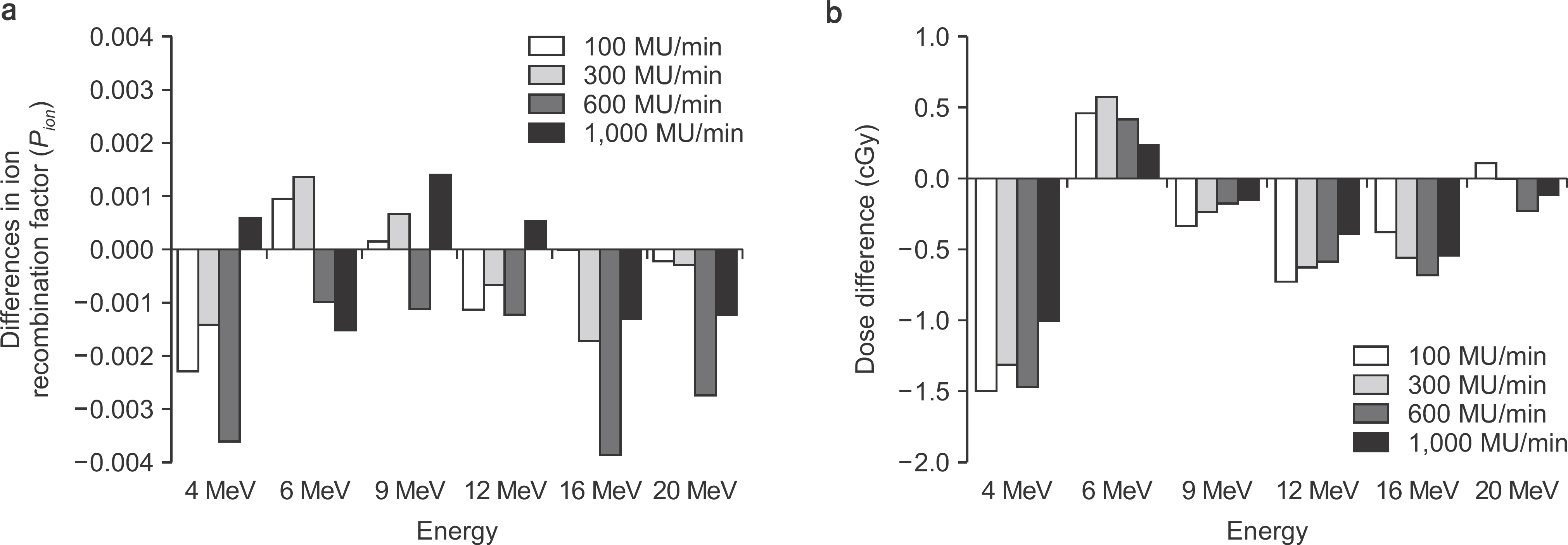Prog Med Phys.
2018 Mar;29(1):16-22. 10.14316/pmp.2018.29.1.16.
Use of Cylindrical Chambers as Substitutes for Parallel-Plate Chambers in Low-Energy Electron Dosimetry
- Affiliations
-
- 1Department of Radiation Oncology, Seoul National University Hospital, Seoul, Korea. madangin@gmail.com
- 2Department of Radiation Oncology, Seoul National University Bundang Hospital, Seongnam, Korea.
- 3Biomedical Research Institute, Seoul National University Hospital, Seoul, Korea.
- 4Institute of Radiation Medicine, Seoul National University Medical Research Center, Seoul, Korea.
- 5Center for Convergence Research on Robotics, Advanced Institutes of Convergence Technology, Suwon, Korea.
- KMID: 2411949
- DOI: http://doi.org/10.14316/pmp.2018.29.1.16
Abstract
- Current dosimetry protocols recommend the use of parallel-plate chambers in electron dosimetry because the electron fluence perturbation can be effectively minimized. However, substitutable methods to calibrate and measure the electron output and energy with the widely used cylindrical chamber should be developed in case a parallel-plate chamber is unavailable. In this study, we measured the correction factors and absolute dose-to-water of electrons with energies of 4, 6, 9, 12, 16, and 20 MeV using Farmer-type and Roos chambers by varying the dose rates according to the AAPM TG-51 protocol. The ion recombination factor and absolute dose were found to be varied across the chamber types, energy, and dose rate, and these phenomena were remarkable at a low energy (4 MeV), which was in good agreement with literature. While the ion recombination factor showed a difference across chamber types of less than 0.4%, the absolute dose differences between them were largest at 4 MeV at approximately 1.5%. We therefore found that the absolute dose with respect to the dose rate was strongly influenced by ion-collection efficiency. Although more rigorous validation with other types of chambers and protocols should be performed, the outcome of the study shows the feasibility of replacing the parallel-plate chamber with the cylindrical chamber in electron dosimetry.
MeSH Terms
Figure
Reference
-
References
1. Almond PR, Biggs PJ, Coursey BM, Hanson WF, Huq MS, Nath R, et al. AAPM's TG-51 protocol for clinical reference dosimetry of high-energy photon and electron beams. Med Phys. 1999; 26:1847–70.
Article2. Andreo P, Burns D, Hohlfeld K, Huq MS, Kanai T, Laitano F, et al. Absorbed dose determination in external beam radiotherapy: an international code of practice for dosimetry based on standards of absorbed dose to water. IAEA TRS. 2000; 398.3. Party IW, Thwaites D, DuSautoy A, Jordan T, McEwen M, Nisbet A, et al. The IPEM code of practice for electron dosimetry for radiotherapy beams of initial energy from 4 to 25 MeV based on an absorbed dose to water calibration. Phys Med Biol. 2003; 48:2929.4. DIN 6800–2. Procedures of dosimetry with probe type detectors for photon and electron radiation – Part 2: Ionization chamber dosimetry of high energy photon and electron radiation, Corrigendum to DIN 6800–2: 2008–03;. 2008.5. Gerbi BJ, Antolak JA, Deibel FC, Followill DS, Herman MG, Higgins PD, et al. Recommendations for clinical electron beam dosimetry: supplement to the recommendations of Task Group 25. Med Phys. 2009; 36:3239–79.
Article6. Laitano RF, Guerra AS, Pimpinella M, Caporali C, Petrucci A. Charge collection efficiency in ionization chambers exposed to electron beams with high dose per pulse. Phys Med Biol. 2006; 51:6419–36.
Article7. Piermattei A, Canne SD, Azario L, Russo A, Fidanzio A, Micelit R, et al. The saturation loss for plane parallel ionization chambers at high dose per pulse values. Phys Med Biol. 2000; 45:1869–83.
Article8. Burns DT, McEwen MR. Ion recombination corrections for the NACP parallel-plate chamber in a pulsed electron beam. Phys Med Biol. 1998; 43:2033–45.
Article9. Martisikova M, Ackermann B, Jakel O. Analysis of uncertainties in Gafchromic EBT film dosimetry of photon beams. Phys Med Biol. 2008; 53:7013–27.10. Kim SH, Huh H, Choi SH, Choi J, Kim HJ, Lim C, Shin DO. The Study on the Use of a Cylindrical Ionization Chamber for the Calibration of a 6 MeV Electron Beam. Korean J Med Phys. 2009; 20:317–323.11. Sathiyan S, Ravikumar M. Absolute dose determination in high-energy electron beams: Comparison of IAEA dosimetry protocols. J Med Phys India. 2008; 33:108.
Article12. Lang S, Hrbacek J, Leong A, et al. Ion-recombination correction for different ionization chambers in high dose rate flatteningfilterfree photon beams. Phys Med Biol. 2012; 57:2819–27.
Article13. Takei , Hideyuki , et al. General ion recombination effect in a liquid ionization chamber in high-dose-rate pulsed photon and electron beams. J Radiat Res. 2018.
Article
- Full Text Links
- Actions
-
Cited
- CITED
-
- Close
- Share
- Similar articles
-
- The Study on the Use of a Cylindrical Ionization Chamber for the Calibration of a 6 MeV Electron Beam
- Determination of Quality Factors for Cylindrical Ionization Chambers in kV X-rays: Review of IAEA Dosimetry Protocol and Monte Carlo Calculations and Measurements for N23333 and N30001 Chambers
- Determination of Beam Quality Correction Factors for the PTW-Markus Chamber for Electron Beam Qualities R50=1.0 and 1.4 g/cm2
- Study on Absorbed Dose Determination of Electron Beam Quality for Cross-calibration with Plane-parallel Ionization Chamber
- Chamber-to-chamber Variations in the Same Type of a Cylindrical Chamber for the Measurements of Absorbed Doses




